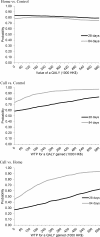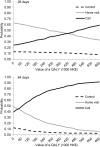Economic evaluation of the differential benefits of home visits with telephone calls and telephone calls only in transitional discharge support
- PMID: 25355620
- PMCID: PMC4255617
- DOI: 10.1093/ageing/afu166
Economic evaluation of the differential benefits of home visits with telephone calls and telephone calls only in transitional discharge support
Abstract
Background: home visits and telephone calls are two often used approaches in transitional care, but their differential economic effects are unknown.
Objective: to examine the differential economic benefits of home visits with telephone calls and telephone calls only in transitional discharge support.
Design: cost-effectiveness analysis conducted alongside a randomised controlled trial (RCT).
Participants: patients discharged from medical units randomly assigned to control (control, N = 210), home visits with calls (home, N = 196) and calls only (call, N = 204).
Methods: cost-effectiveness analyses were conducted from the societal perspective comparing monetary benefits and quality-adjusted life years (QALYs) gained.
Results: the home arm was less costly but less effective at 28 days and was dominating (less costly and more effective) at 84 days. The call arm was dominating at both 28 and 84 days. The incremental QALY for the home arm was -0.0002/0.0008 (28/84 days), and the call arm was 0.0022/0.0104 (28/84 days). When the three groups were compared, the call arm had a higher probability being cost-effective at 84 days but not at 28 days (home: 53%, call: 35% (28 days) versus home: 22%, call: 73% (84 days)) measuring against the NICE threshold of £20,000.
Conclusion: the original RCT showed that the bundled intervention involving home visits and calls was more effective than calls only in the reduction of hospital readmissions. This study adds a cost perspective to inform policymakers that both home visits and calls only are cost-effective for transitional care support, but calls only have a higher chance of being cost-effective for a sustained period after intervention.
Keywords: cost-effectiveness analysis; home visits; hospital readmissions; older people; telephone calls; transitional discharge support.
© The Author 2014. Published by Oxford University Press on behalf of the British Geriatrics Society.
Figures
References
-
- Wong FKY, Ho MM, Yeung S. Effects of a health-social partnership transitional programme on hospital readmission: a randomized controlled trial. Soc Sci Med. 2011;73:960–9. - PubMed
-
- Naylor MD, Brooten DA, Campbell RL, et al. Transitional care of older adults hospitalized with heart failure: a randomized, controlled trial. J Am Geriatr Soc. 2004;52:675–84. - PubMed
-
- Mistiaen P, Poot E. Telephone follow-up, initiated by a hospital-based health professional, for postdischarge problems in patients discharged from hospital to home. Cochrane Database Syst Rev. 2006 DOI:10.1002/14651858.CD004510.pub3. - DOI - PMC - PubMed
Publication types
MeSH terms
LinkOut - more resources
Full Text Sources
Other Literature Sources
Miscellaneous



